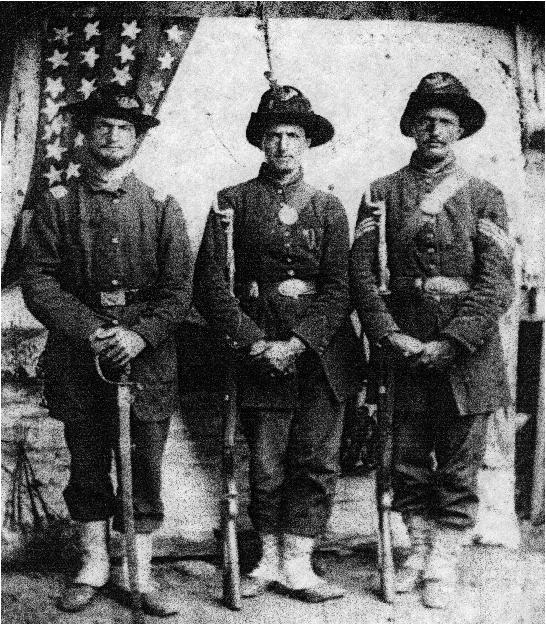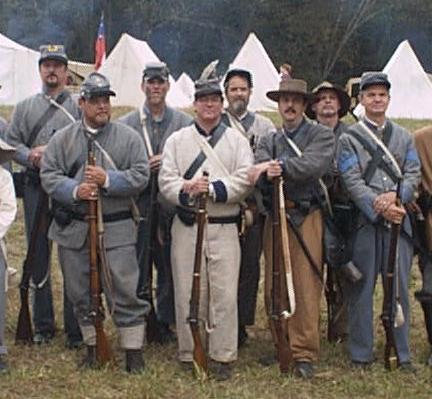
Rest, Rest, Rest, and Rest!
or
Don't let established reenacting practices interfere with period
practices
by
Mark (Silas) Tackitt
A review of standard reenacting practices for the commands of parade-rest, in place-rest, and rest reveal discrepancies between past and present practices. Reenactors should be use actual commands from period manuals, not commands from the last reenactment.
1. Parade Rest
When the command, "Parade - Rest," is ordered during parade, reenactors generally follow the rule as stated by Hardee:
Being on parade or at order arms, if it be wished to give the men rest, the command will be:
Parade-REST.
At the command rest, turn the piece on the heel of the butt, the barrel to the left, the muzzle in front of the centre of the body; seize it at the same time with the left hand just above, and with the right at the upper band; carry the right foot six inches to the rear, the left knee slightly bent.
U.S. Infantry Tactics (1861), pp. 191-92.
Although this command is taken directly from the pen of William Hardee, it is removed from context. This command is found in the manual for relieving sentinels, not for attending parade. The men should stand in the manner prescribed by the army regulations for parade, not for some other purpose.
Not surprisingly, the regulations for both the Federal and Confederate armies are identical. Each states:
On all parades of ceremony, such as Reviews, Guard-mounting, at Troop or Retreat parades, instead of the word "Rest," which allows the men to move or change the position of their bodies, the command will be "PARADE-REST!" At the last word of this command, the soldier will carry the right foot six inches in rear of the left heel, the left knee slightly bent, the body upright upon the right leg; the musket resting against the hollow of the right shoulder, the hands crossed in front, the backs of them outward, and the left hand uppermost. At the word "ATTENTION!" the soldier will resume the correct position at ordered arms. In the positions here indicated, the soldier will remain silent and motionless; and it is particularly enjoined upon all officers to cause the commands above given, on the part of tale soldier, to be executed with great briskness and spirit.
Officers on all duties under arms are to have their swords drawn, without waiting for any words of command for that purpose.
Revised United States Army Regulations of 1861, with an Appendix Containing the Changed and Laws Affecting Army Regulations and Articles of War to June 25, 1863 (Washington, U.S. Gov't Printing Office), para's 335-36; "Regulations for the Armies of the Confederate States", (Richmond, War Department, 1863), para's 322-23 (Emphasis added).
Under the regulations, the musket should be leaned against the hollow of the right shoulder rather than the standard reenacting practice of holding the musket away from the body. Also, the hands should be placed across the body at the waist rather placed on the musket towards the upper band.
Below is a period photo of two soldiers standing in the regulation manner. The three soldiers are the Booth brothers: Lt. Willam, Pvt. George, and Sgt. Samuel, all of the 2nd Wisconsin V.I. Company C, likely taken in May or early June 1862 at Fredericksburg).

A caveat: Although the against-the-shoulder method is taken directly from the regulations, photos of soldiers standing in this manner are rare. The against-the-shoulder method is seen more frequently in early war photos than late war photos. Some argue the shoulder method was a holdover from the smoothbore days which was also practiced by companies using the two band rifle with the sword bayonet. The bulk of wartime photos picture individual soldiers or entire units standing in the typical, musket-across-the-body method. The across-the-body method is frequently seen with companies using the rifle musket. So, what is proper? Depends upon the manual, small arm, theater, and year portrayed by the reenacting unit.
2. In Place - Rest
The manner in which reenactors stand is identical to parade rest: the right foot is carried six inches in rear of the left heel, the left knee slightly bent, and the body upright upon the right leg. The musket remains in its former position without turning or moving. The right hand seizes the musket at the upper band, and the left hand placed on the forearm of the right and near the wrist. Below is a photo of reenactors performing said movement:

The problem with this practice is that it is a reenactorism. This practice does not exist in any period manual. It has been attributed to the U.S. Volunteers reenactment unit which created the command in the 1980's. The idea behind the practice is that it created a semi-formal manner to stand but which allowed the reenactor to speak freely. Unfortunately, it has become the accepted method method most reenactors use when standing in a parade-type formation.
The relevant manuals provide a less formal manner of standing than is presently practiced. According to the U.S. Tactics:
37. The instructor, wishing to rest the men, without deranging the alignment, will first-cause arms to be supported, or ordered, and then command: In place-REST.
38. At this command, the men will no longer be constrained to preserve silence or steadiness of position; but they will always keep one or other heel on the alignment.
U.S. Infantry Tactics (School of the Company), pg. 96.
According to Hardee's Revised Tactics:
If the instructor wishes merely to relieve the attention of the recruit, he commands, in place-REST; the soldier is then not required to preserve his immobility, but he always keeps one of his feet in its place.
Rifle and Infantry Tactics, Revised and Improved by Brig. Gen. W.J. Hardee, C.S. Army (1862), (School of the Soldier), para. 73.
Under these two manuals, the soldier may stand with either foot on the line. As no provision is made for the handling of the musket, it may be held at will. In theory, a front rank soldier could pivot on the right foot, face soldiers in the rear rank, and maintain a conversation with them.
3. Rest from the Support Position.
A resting position similar to in-place rest is the command of rest while the men are at the support. Typically, a junior commander at a reenactment will order the command, "Rest," when the men are standing in formation waiting for some other unit to complete some task. The idea is to relieve the weight of the musket by using both arms to support it. Silence is not demanded, but it is expected. Regarding placement of the feet, they are usually placed in the Parade Rest position. Although well intentioned, this command is wrong.
According to Winfield Scott's manual, if the troops are at support arms, the instructor may command: "REST".
168. At this command, the recruits will bring up smartly the right hand to the handle of the piece, (small of the stock,) when they will not be required to preserve silence, or steadiness of position. They, however, will not quit their rank without special permission.
169. To pass from rest to the prescribed fixed position, the instructor will command: 1. Attention. 2. SQUAD.
Scott, para's 167-69. Similar provisions are found in U.S. Tactics (School of the Soldier), 136-39.
Reenactors often receive this command, but few of the men avail themselves of its full power. The allowances in the commands for in-place rest and "support rest" are the same:
"...the men will no longer be constrained to preserve silence or steadiness of position..." (in-place rest)
"...they will not be required to preserve silence, or steadiness of position..." ("support rest")
As both commands contain essentially the same terminology, they should be executed in the same manner: the men may stand with either heel on the line and they may speak.
4. Rest
This command is frequently used, but not to its fullest advantage.
39. If, [ ] the instructor should wish to rest the men without constraining them to preserve the alignment, he will command: REST.
40. At which command, the men will not be required to preserve immobility, or to remain in their places.
U.S. Infantry Tactics (1861), p. 96, para's 39-40 of the School of the Company.
This method is essential the same in Hardee's revised manual of 1862:
73. At the command REST, the soldier is no longer required to preserve immobility, or to remain in his place.
Reenactors receive this command from a regular formation. Upon receiving the command, all formation is lost while the men scatter to the shade of the trees. Reforming the ranks takes time. To preserve the alignment of the unit, arms should be first stacked then the command given. Sets of stacked arms preserve the battalion's alignment while giving men a rest.
This concept is contained in Scott's Evolutions of the Line which is tactics designed for a "corps d'armee of two divisions or four brigades." See, Vol. 3, Scott, para 1716. As noted in paragraphs 1766 - 67 of Scott's manual,
If, after arms are ordered, the general wishes to cause arms to be stacked, he will command: Stack arms.
This having been repeated, the colonels will cause the stacks to be formed; which being executed, each will immediately cause ranks to be broken, without regulating himself by any other colonel....
An individual company may reform its ranks quickly by either method. However, the reformation of a battalion, regiment, brigade, or division without first stacking arms would take a long time. Accordingly, each company should stack arms or before receiving the command of rest.
This concept is also contained in the U.S. Tactics:
40. At which command [Rest], the men will not be required to preserve immobility, or to remain in their places.
41. The instructor may, also, when he shall judge. proper, cause arms to be stacked, which will be executed as prescribed, school of the soldier.
U.S. Infantry Tactics (1861), p. 96, para's 40 - 41 of the School of the Company.
5. Conclusion
Reenactors do not need to recreate the wheel. The "how's" on the various forms of rest are contained in the texts noted above. One text, Baxter's Manual for Volunteers, contains three of the four commands in a few consecutive paragraphs:
REST.
At this, the recruit will not be required to preserve the steadiness of his position. Neither is he required to keep silent. If he leave his position, it should not be out of sight or hearing of his commanding officer, without permission. If the command,
In Place- REST,
should be given, instead of the above, the same freedom will be permitted except that no man shall leave his place. If, on the other hand, strict silence is required, and the men should be brought to a position of rest, the command will be:
Parade-REST.
Carry back the right foot about four inches to the rear, (without moving the left); rest the weight of the body on that leg, bending the knee but slightly; cross the hands on front of the body, the left hand on top and supporting the right wrist; shoulders square to the front; head erect, and the eyes meeting the ground fifteen paces in advance. In this position, remain steady until the command:
Attention-SQUAD,
is given. At the word SQUAD, bring up the right heel beside the left, drop the hands, and take the position of a soldier at ATTENTION.
Mark (Silas) Tackitt reenacts in the Pacific Nor'west with the 44th Tennessee Consolidated Infantry.